
Land and Housing | Policy Research & Advocacy Series
Opportunity for Brownfield Resettlement and Industry Upgrading – Vehicle Maintenance Industry as an Illustration
[Presentation Slides (Read Flipbook)(Chi Only)]
[Presentation Slides (Download PDF)(Chi Only)]
Our Hong Kong Foundation (OHKF) published its advocacy research on the development of industrial land. Through utilising multi-storey buildings (MSBs) for modern industries and establishing diversified industrial chains, these will facilitate industry upgrading and transformation, orderly consolidation of brownfield sites, enhance land use efficiency, and foster the development of the Northern Metropolis.
Using the vehicle maintenance industry as an illustration, OHKF put forward three policy recommendations, namely: 1) Encourage vehicle manufacturers and dealers to commit to opening up electric vehicle (EV) maintenance technologies to the industry when introducing new EV models; 2) Enhance the development strategy of MSBs and brownfield consolidation policies; and 3) Build a new generation of iconic multi-purpose automobile city to develop diversified industrial chains.
2023-08-31
Development Strategies for San Tin Technopole: From Ground Zero to Innovation Hub
[Research Summary (Read Flipbook)]
[Full Contents (Read Flipbook)]
[Research Summary (Download PDF)]
[Full Contents (Download PDF)]
Our Hong Kong Foundation (OHKF) released its latest policy advocacy report entitled Development Strategies for San Tin Technopole: From Ground Zero to Innovation Hub today. The report focuses on three areas, namely lead development entity, business and investment attraction, as well as land allocation and development. Through analysing various case studies of successful innovation and technology (I&T) parks globally, including Mainland China, Singapore, the United Kingdom, and the United States, the report crystalises relevant development models that provide valuable references for the Government.
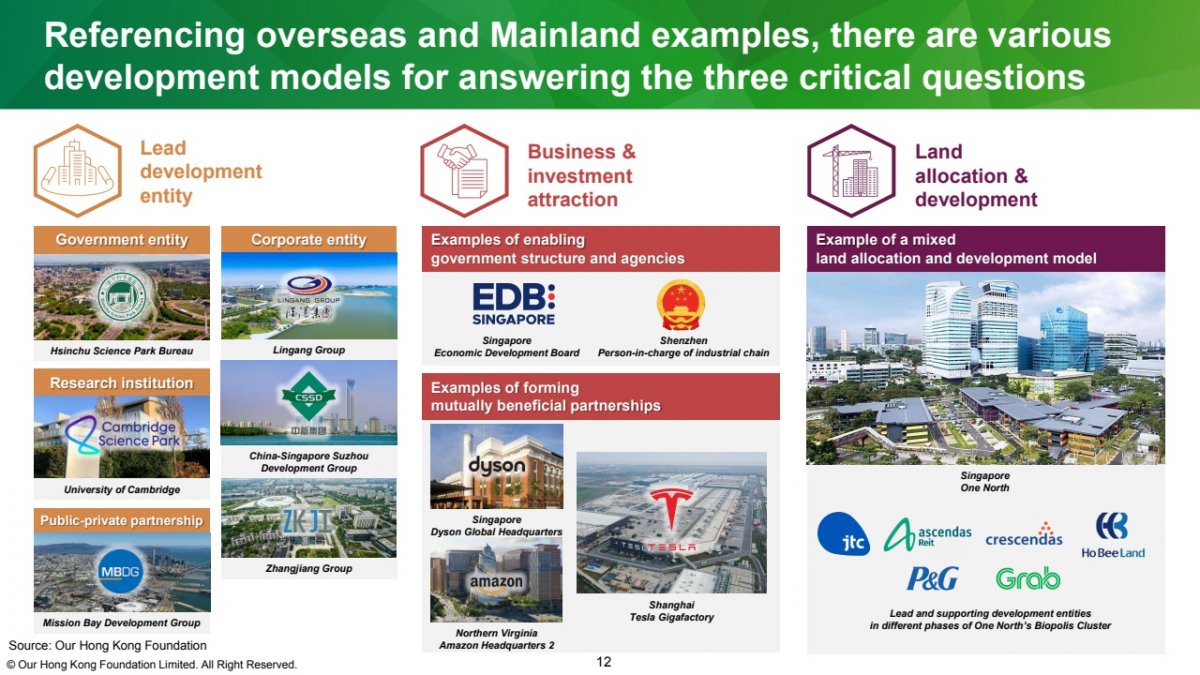
Combining global experiences with the local context, OHKF put forward 13 policy recommendations under 5 directions. Besides a smooth launch for San Tin Technopole (STT), these recommendations aim to realise the vision set out in the Hong Kong Innovation and Technology Development Blueprint, and forge a new engine for Hong Kong’s socio-economic development.
(Direction 1) Government-led development supplemented by private participation:
Recommendation 1: Provide concessionary land premium for in-situ land exchange, subject to securing prospective I&T enterprises.
Recommendation 2: Allow landowners to construct talent accommodation, pegged to the scale of I&T operations on their respective sites.
Recommendation 3: Introduce co-investment via the issuance of STT Development Bonds.

(Direction 2) Strengthen implementation mechanisms and monitor the effectiveness of investment attraction:
Recommendation 4: Form a new business-centric working group on STT for swift and precise investment attraction.
Recommendation 5: Set KPIs for the new Working Group to monitor its effectiveness.
(Direction 3) Stand out via aggressive investment attraction while ensuring mutually beneficial partnerships:
Recommendation 6: Offer tailor-made incentives and a compelling business proposition to stand out from the competition.
Recommendation 7: Leverage key decision influencers for all-round pitching, amplifying the reach and effectiveness of investment attraction efforts.
Recommendation 8: Assign enterprises performance-based KPIs to ensure mutually beneficial partnerships.
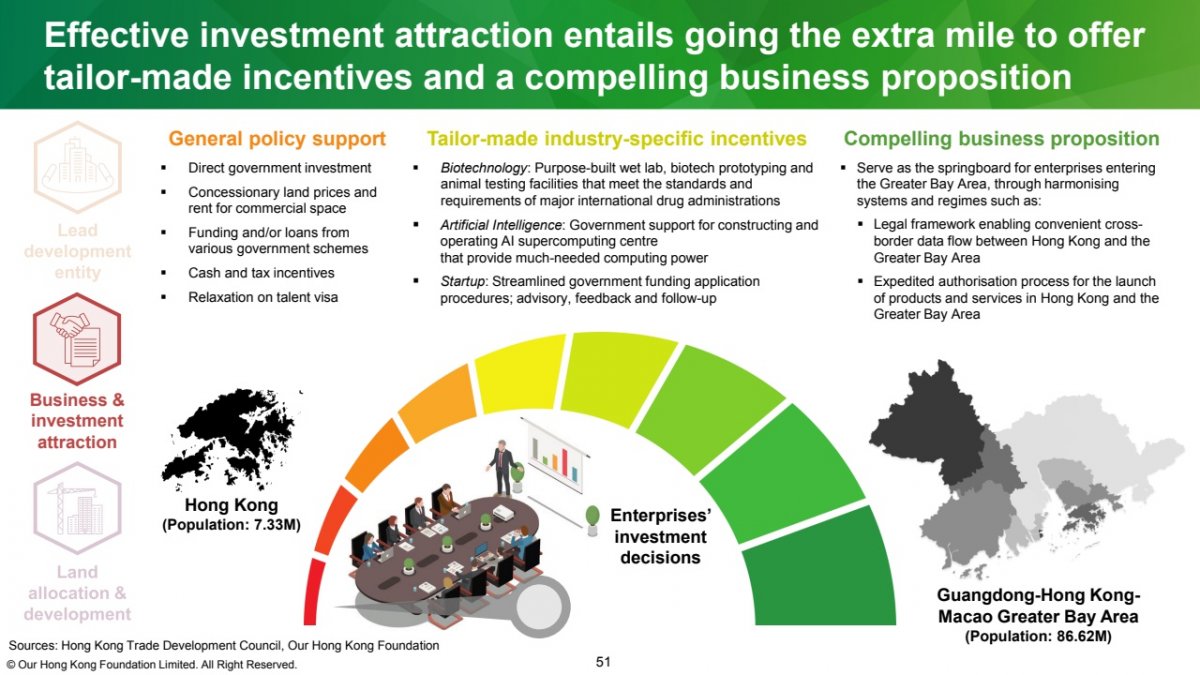
(Direction 4) Foster a liveable community and vibrant I&T ecosystem:
Recommendation 9: Enhance transport connections of the I&T land through advanced planning.
Recommendation 10: Kickstart the development of the I&T ecosystem with government research agencies and academic institutions as anchor institutions.
Recommendation 11: Implement new urban design concepts to create a liveable mixed-use community.
(Direction 5) Land allocation and development based on ecosystem maturity:
Recommendation 12: Adopt a multitude of land allocation methods, subject to ecosystem maturity and industry needs.
Recommendation 13: Design buildings based on enterprises’ needs to avoid becoming “building waste”.
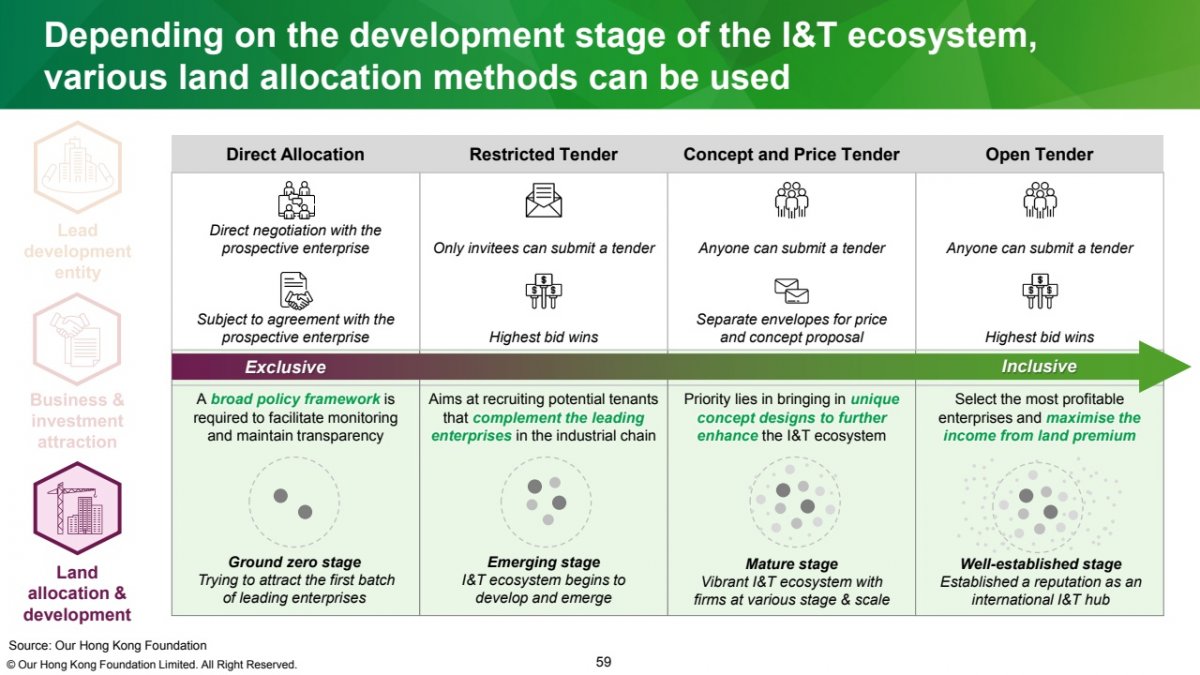
2023-04-27
10-Year Housing Supply Forecast 2023
[Full Report (Read Flipbook)]
[Executive Summary (Read Flipbook)]
[Full Report (Download PDF)]
[Executive Summary (Download PDF)]
Our Hong Kong Foundation (OHKF) released its latest exclusive public and private housing supply forecast, which expects a significant improvement in supply for the next five years. Looking forward, the Government should seize the opportunity to release the untapped development potential of the Northern Metropolis to ensure achieving its ten-year target in the Long Term Housing Strategy (LTHS). It is by doing so that a solid foundation can be laid to enhance Hong Kong’s living quality and gradually head toward a more livable city.
For public housing, in the premise of the timely delivery of Light Public Housing, the Composite Waiting Time is likely to be shortened and close to achieving the Government’s performance indicator. As the Government first announced last year the distribution of public housing sites estimated to be completed in the second five-year period, and given the measures set out in the Policy Address to reduce recurrent delays, total completions in the next 10 years could exceed the LTHS target. However, as 60% of the projected supply in the second five-year period will come from the Northern Metropolis, and half of them belong to scattered rezoning lands, possible extended time on land resumptions and clearance procedures will be expected.
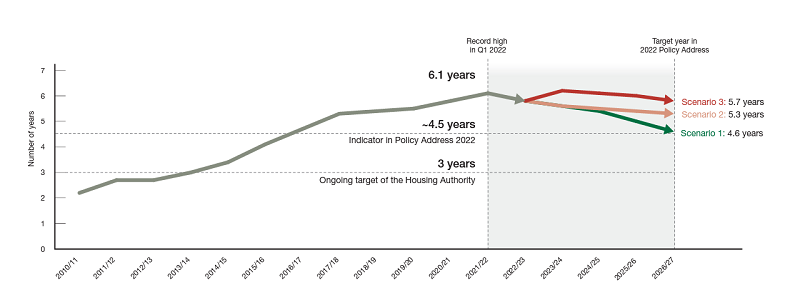
For private housing, assuming the successful implementation of favourable policy measures such as streamlining development procedures, completions are expected to reach a relatively high level in the next five years. However, expected completions in the second five-year period significantly contrast the first five-year period figure with a nearly 30% drop. The sharp decline in spade-ready land supply for private housing in recent years has foreshadowed the slump in completion level five years from now. Nevertheless, in addition to known projects, many private development projects in the Northern Metropolis are undergoing planning applications. There is a high degree of overlap between their geographical distribution and the potential developable areas identified by OHKF. To unleash the development potential in these areas, the Government must tackle the challenges in traffic, sewage, conservation, and not-in-my-backyard facilities.
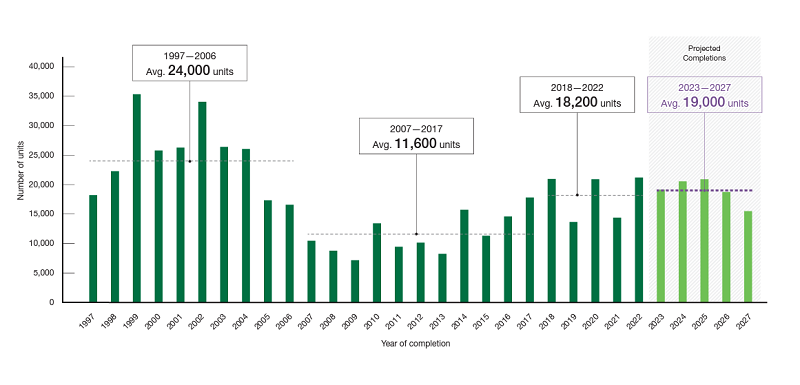
For market dynamics, the Government’s relaxation on the mortgage rules and increased supply of subsidised housing considerably reduced the attractiveness of smaller units, while it was observed that the sales ratio of mid-size units has overtaken smaller units. The earlier trend of first-time buyers scrambling for units with a smaller lump sum, irrespective of size, to get a foot on a rug of the property ladder is retreating. It is anticipated that the proportion of smaller units in new private housing completions is going to reach its peak this year, and completions of nano-flats are expected to rise but will plateau from 2024 to 2025.
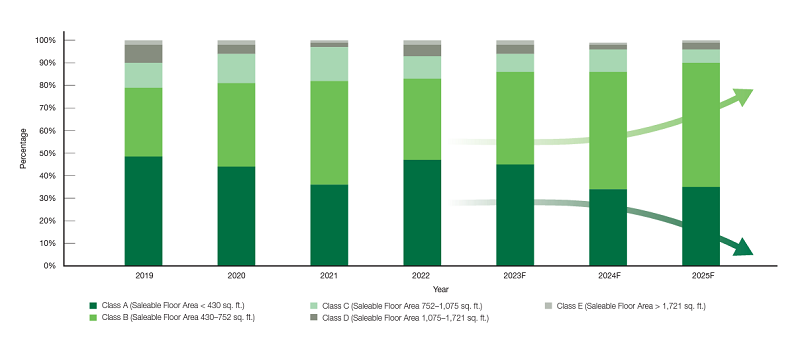
2023-3-22
Homeownership and Youth Social Mobility
[Presentation Slides (Read Flipbook)(Eng Version)]
[Presentation Slides (Read Flipbook)(Chinese Version)]
[Presentation Slides (Download PDF)(Eng Version)]
[Presentation Slides (Download PDF)(Chinese Version)]
Our Hong Kong Foundation (OHKF) published its advocacy research on youth homeownership and social mobility. Through scrutinising income data of various education levels in the past three decades, this study delves into the phenomenon of youth housing predicament and lack of social mobility, and proposes enhancements in subsidised housing policies as a solution.
To this end, OHKF recommends that the Government extend the mortgage guarantee period for second-hand Home Ownership Scheme (HOS) flats to reduce the down payment required for purchasing an older second-hand HOS flat; fully open up the HOS secondary market to increase choices available for first-time homebuyers and increase unit turnover, and; refine the balloting system of subsidised sale flats to improve the success rate of applicants with multiple failed applications.
2022-9-19
Transport infrastructures to pave the way for a thriving northern New Territories
[Presentation Slides (Read Flipbook)(Chi Only)]
[Presentation Slides (Download PDF)(Chi Only)]
Our Hong Kong Foundation (OHKF) published an advocacy paper on the strategic transport infrastructures, which proposes three new highway and railway alignments: the North-South Expressway, the East-West Expressway, and the North-South Railway. Complementing the Government’s plan on transport infrastructures, OHKF’s recommendations will enhance the vertical connectivity of the CBDs across Shenzhen, the Northern Metropolis, and the Harbour Metropolis, as well as improve the intra-district horizontal connectivity within the New Territories.
The three proposed transport infrastructures will help unlock the development potential of the land along the alignment, particularly the plains in Fanling South, Lam Tsuen, Kam Tin and southeast of Yuen Long, which could create synergy with the Northern Metropolis. At the same time, the new infrastructures will divert the heavy traffic between the New Territories and the metro area, allowing the public to experience more convenient and comfortable journeys.
2022-5-31
Annual 10-Year Housing Supply Forecast
[Full Report (Read Flipbook)]
[Executive Summary (Read Flipbook)]
[Presentation Slides (Read Flipbook)]
[Full Report (Download PDF)]
[Executive Summary (Download PDF)]
[Presentation Slides (Download PDF)]
Our Hong Kong Foundation is launching its latest exclusive annual forecast on housing supply. We intend to help members of the public stay informed of the latest land and housing supply trends, and assist the Government in identifying critical policy gaps for speedy resolution.
This report intends to help members of the public stay informed of the latest land and housing supply trends, and assist the Government in identifying critical policy gaps for speedy resolution. The forecast shows that short-term supply is still largely dependent on stopgap measures such as land rezoning, while long-term supply is full of uncertainties.
For private housing, mild improvements are observed in the short-term supply, but there is a chance of a supply chasm in the long-term before the "mainstay" of supply in the New Development Areas (NDAs) materialise in the 2030s. Therefore, the key to increasing supply is to expedite the NDAs and advance land delivery to avoid a supply chasm. At the same time, accelerating infrastructure projects in the NDAs will also help unlock the development potential of the private land bank and further increase private residential supply.
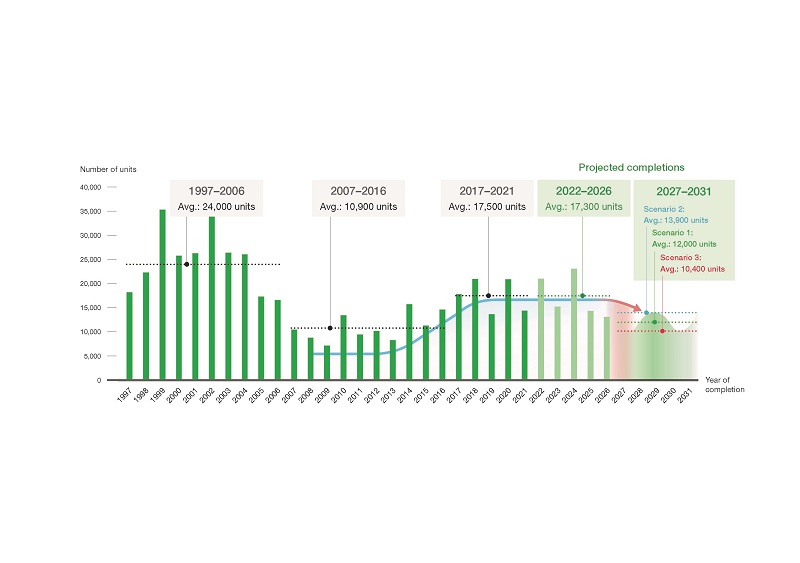
For public housing, short-term supply has witness snowballing deficit vis-à-vis Government targets, while uncertainties to fulfil the “back-loaded” supply pledge remains. The outlook is pessimistic due to the Government's poor track record, recurrent delays in completions, and a lack of transparency in project progress disclosure. Therefore, the key to meeting the target is to break the current vicious cycle of delays in public housing projects to ensure their timely delivery.
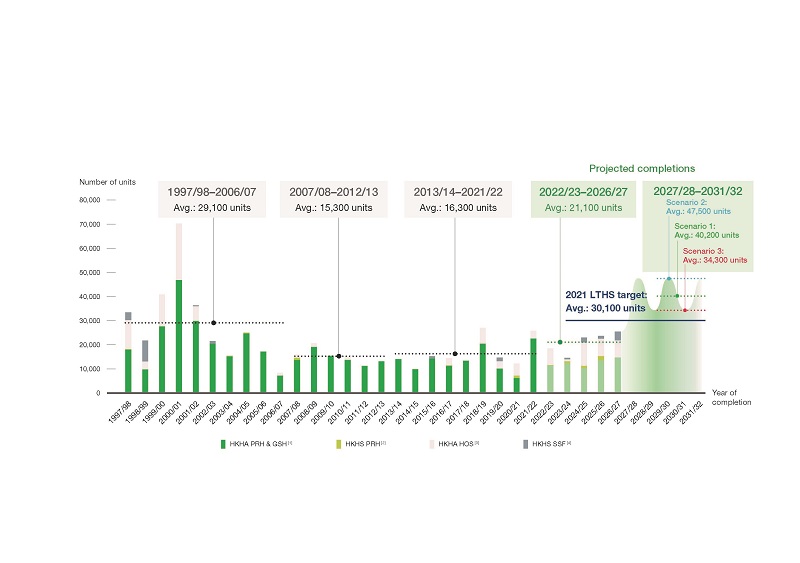
As currently known public housing project delays only form the "tip of the iceberg", we have conducted a site visit to uncover three lesser-known delay cases, and shed light on the problems that have yet to emerge.
Looking beyond supply numbers, unit sizes in upcoming private housing completions are still declining, while nano-flat completions will continue rising in the short term. Despite gradually plateauing in 2024 to 2025, it is too early to conclude that we have seen the back of nano-flats. Unit sizes in public housing are likewise declining, with nano-flats not only plaguing Green Form Subsidised Home Ownership Scheme (GSH) projects, but also making a debut in the Home Ownership Scheme (HOS) projects launched for sale in 2022. It remains to be seen whether the Government will consider increasing the size of new public housing units.
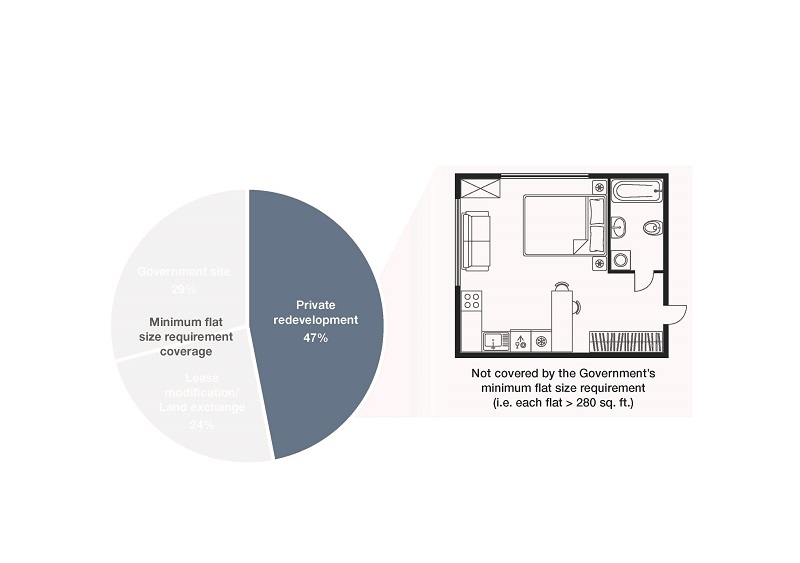
2022-1-24
Immediate Actions to Resolve Hong Kong's Housing Conundrum: Cut the Red Tape Now!
[Full Report (Read Flipbook)]
[Executive Summary (Read Flipbook)]
[Presentation Slides (Read Flipbook)]
[Full Report (Download PDF)]
[Executive Summary (Download PDF)]
[Presentation Slides (Download PDF)]
Our Hong Kong Foundation (OHKF) published its latest Land & Housing Policy Research Report, Immediate Actions to Resolve Hong Kong's Housing Conundrum: Cut the Red Tape Now!
This report urges the Hong Kong SAR Government (Government) to seize the opportunity to dismantle the barriers to land and housing supply, by addressing the three major pain points of cumbersome vetting and approval process, civil service inefficiency and a lack of social consensus. Correspondingly, this report proposes three major recommendation directions, namely Speed Up, Efficiency Up and Mass Up, covering 23 detailed recommendations, with the goal of closing the housing gap in the short term and shorten the waiting time for public housing.
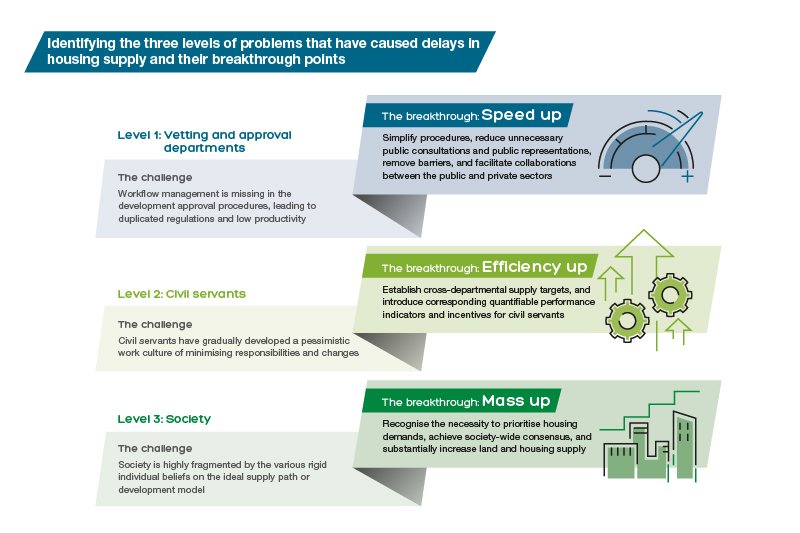
In order to solve the problem of cumbersome and lengthy development approval process, this report synthesizes the professional opinions of various parties to make recommendations that cover the whole process of land and housing development, from upstream to downstream.
Large-scale development projects, such as reclamation and New Development Areas (NDAs), generally take 14 years or more from preliminary planning to the first batch of spade-ready land supply. We propose to simplify and consolidate public engagement under various ordinances, leverage on market forces to accelerate land assembly, commence detailed design, land resumption and site formation in all phases in parallel, and proceed with reclamation works and town planning procedure for superstructure developments simultaneously.
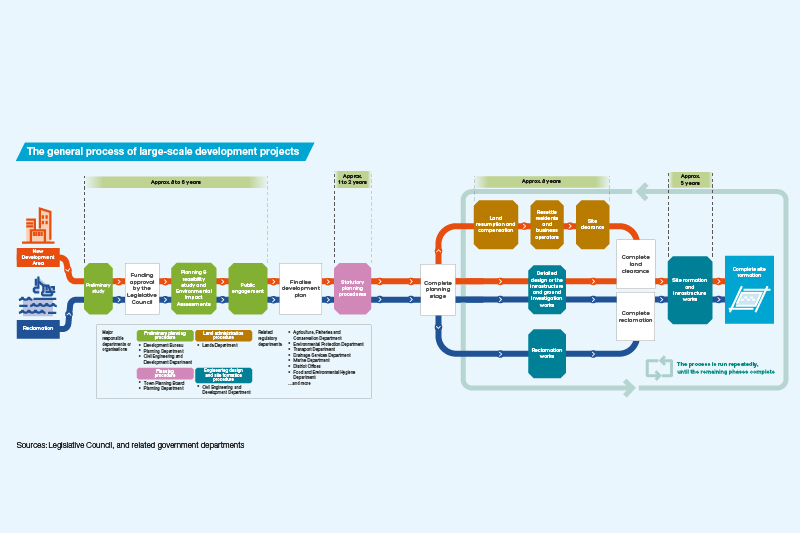
Apart from the large-scale development projects implemented by the Government, private housing developments mainly come from rezoning of agricultural land, Comprehensive Development Areas (CDAs) and urban redevelopment, which often take more than 10 years to develop. We propose to enhance the town planning procedure, simplify land leases, accelerate the lease modification procedure, divide CDAs into smaller sites and establish clear approval criteria for Master Layout Plan (MLP), and strengthen the functions of the Development Project Facilitation Office (DPFO).
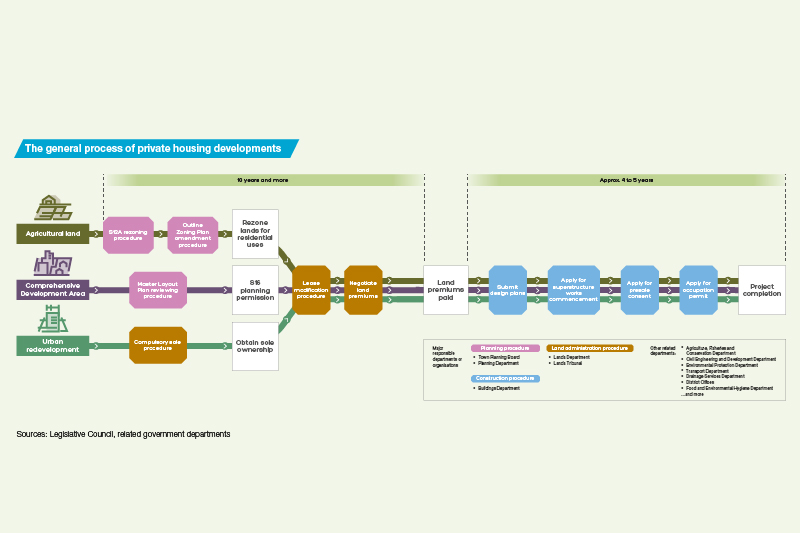
Also, outside of the large-scale development project boundaries, the Government develops public housing mainly through rezoning and redevelopment of aged estates, which often take more than 10 years from preliminary planning to completion. We propose that the related departments should balance relevant feedbacks with professional judgement, make good use of market forces to enhance development efficiency, and establish a “one-stop” platform to disclose the progress of each public housing project.
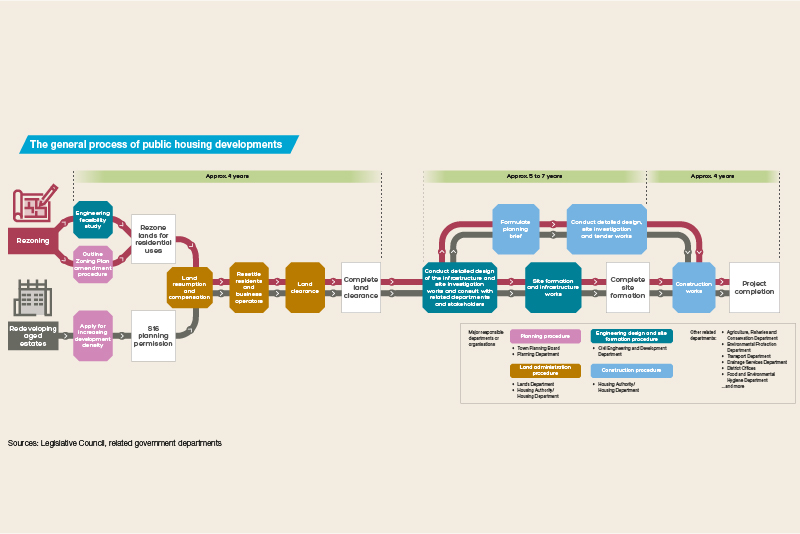
2021-7-23
Developing the New Territories and cutting red tapes to expedite land and housing supply
[Presentation Slides (Read Flipbook)]
[Presentation Slides (Download PDF)]
Our Hong Kong Foundation (OHKF) has published policy recommendations on developing the New Territories and streamlining procedures. By promoting the completion of more New Development Areas (NDA) and minimising the red tapes seen in housing development cycles, the recommendations therein can speed up land and housing supply. The OHKF has put forward specific proposals in three areas, namely, NDA, public housing and private housing. These include exploring various mechanisms for land assembly, enhancing the disclosure on project progress and optimising land administration procedures, with a view to enriching the policy “toolbox” and enhancing the efficiency of development projects. Apart from the short to medium term measures, the OHKF has also made strategic policy recommendations on the overall planning of Hong Kong, such as examining the reasonable proportion of green areas in the territory, to unleash the possibility of more comprehensive development in Hong Kong.
2021-7-8
Building a Global City of the Future – Envisioning Sustainable Urbanisation of the New Territories
[Full Report (Read Flipbook)]
[Executive Summary (Read Flipbook)]
[Presentation Slides (Read Flipbook)]
[Full Report (Download PDF)]
[Executive Summary (Download PDF)]
[Presentation Slides (Download PDF)]
Our Hong Kong Foundation (OHKF) published its latest Land & Housing Policy Research Report, Building a Global City of the Future – Envisioning Sustainable Urbanisation of the New Territories.
This report highlighted Hong Kong’s remarkably low level of urbanisation as the urbanised area with well-planned usages only consists of 20% of Hong Kong’s landmass, much lower than 47% in Shenzhen and 73% in Singapore. In the upcoming three decades, Hong Kong will need at least 9,000 hectares of land according to OHKF’s estimate based on practical needs. However, the major land supply measures planned by the Government has so far contributed 5,000 hectares only.
As the current land shortage is mainly attributed to the fact that no new town has been built in the past twenty years, this report emphasises the importance of planning and creating land on a sustained basis. With the major land creation efforts such as the Lantau Tomorrow Vision and the New Territories North in full swing, OHKF identified a paramount need to start looking for the next batch of New Development Areas (NDAs) to succeed these two projects. In anticipation of the dynamics ahead in the long-term future, OHKF lay out a visionary and pragmatic roadmap towards the 2030s and beyond.
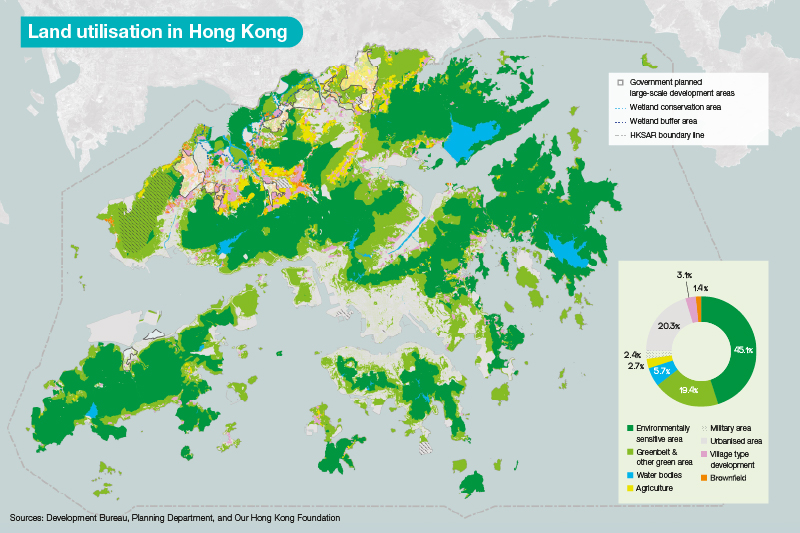
In this report, we present nine Potential Development Areas (PDAs) for further study. They are extended from existing new towns and planned NDAs, forming a massive development belt with over 3,000 hectares that is comparable to Hong Kong’s core urban area. With thorough planning intended for large-scale development, new infrastructures can be constructed to fully release the development potential of fragmented brownfield areas, farmlands, and other underutilised areas.
The planned NDAs and the proposed PDAs are categorised into three development themes, namely Culture & Technology Corridor, Modern Logistics & Business Circle, and Living & Recreation Space, to complement the planning intentions of the ongoing projects implemented by the Government.
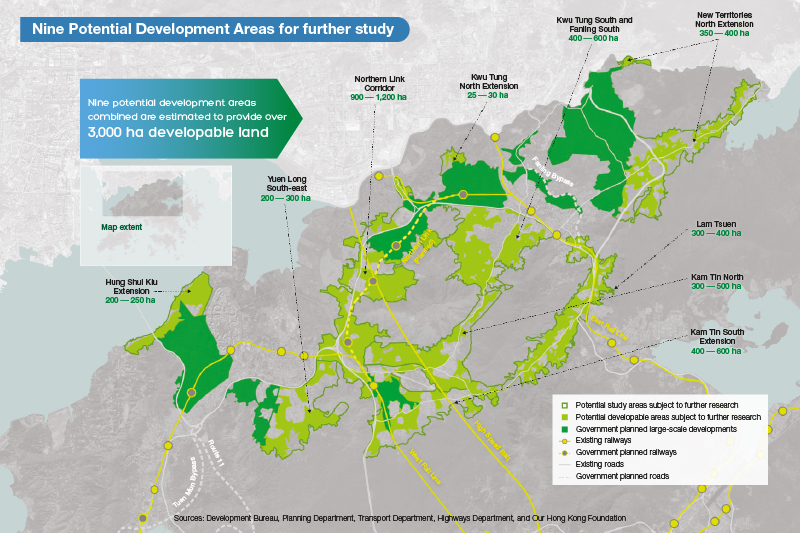
While the previous three generations of new towns saw their first population intake within 7.5 years on average, it takes approximately 17 years for the recent NDA projects to do the same. This report identifies three major hindrances in urbanising the New Territories: the under-provision of infrastructure, difficulties in aligning stakeholders’ interests, and failing land and housing policies. OHKF put forward a range of policy recommendations to equip the society and the Government with more tools to expedite both the ongoing NDA projects and the forthcoming ones.
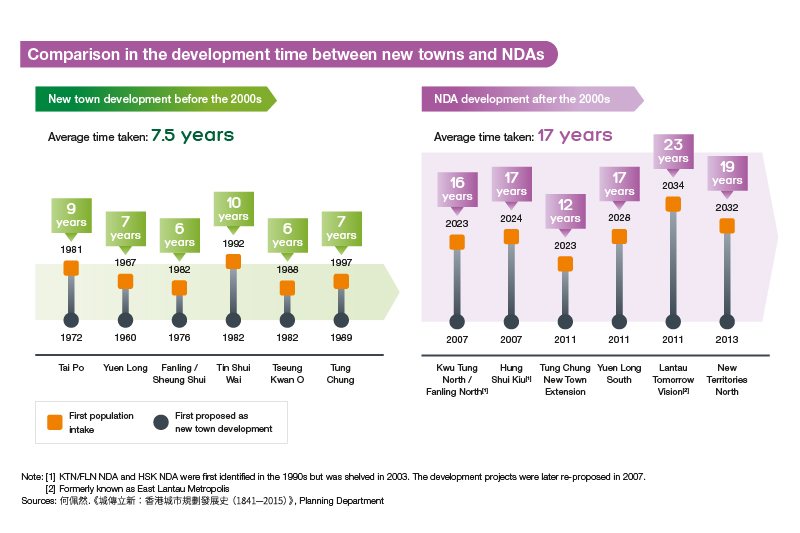
2021-4-21
Decisive Moment — Can Hong Kong Save Itself from the Land and Housing Supply Crisis?
[Full Report (Read Flipbook)]
[Executive Summary (Read Flipbook)]
[Presentation Slides (Read Flipbook)(Chi Only)]
[Full Report (Download PDF)]
[Executive Summary (Download PDF)]
[Presentation Slides (Download PDF)(Chi Only)]
On 21 April 2021, Our Hong Kong Foundation (OHKF) has released a new research report on Land and Housing policy entitled Decisive Moment — Can Hong Kong Save Itself from the Land and Housing Supply Crisis? The Report points out that Hong Kong is caught in a deadlock of “triple lows”, respectively in spade-ready land supply, housing completions, and quality of living. A Herculean effort is needed from the HKSAR Government to achieve the ten-year Long Term Housing Strategy (LTHS) housing supply target. The OHKF provides an exclusive ten-year forecast on public and private housing supply. We urge the Government to take immediate action by expediating all land supply initiatives and spare no effort in streamlining the approval processes for land and housing development.
Hong Kong has been increasingly plagued by a lack of good-quality land for housing due to the lack of large-scale land development over the past 20 years, and the stock from existing new towns has been gradually exhausting. The Report cites the land available for private residential development as an example, with the supply falling from the peak level of 25,500 units recorded three years ago to 13,020 units this year. The report forecasts that the number of private residential completions in the next five years will average only approximately 15,000 units per year. This is 28% lower than the 20,900 units completed last year. Public housing supply in the next four years is also expected to lag behind the LTHS target by 28%, with an annual average of 21,800 units. The shortage in supply will also cast a negative light on the quality of living, as Hong Kong people will suffer from the consequence of living in smaller and more expensive flats. It is predicted that the average gross floor area of newly completed private housing units will continue to shrink to less than 600 square feet in 2024, almost one-third smaller than in 2012 (which is equivalent to a saleable area smaller than 480 square feet based on an 80% efficiency ratio).
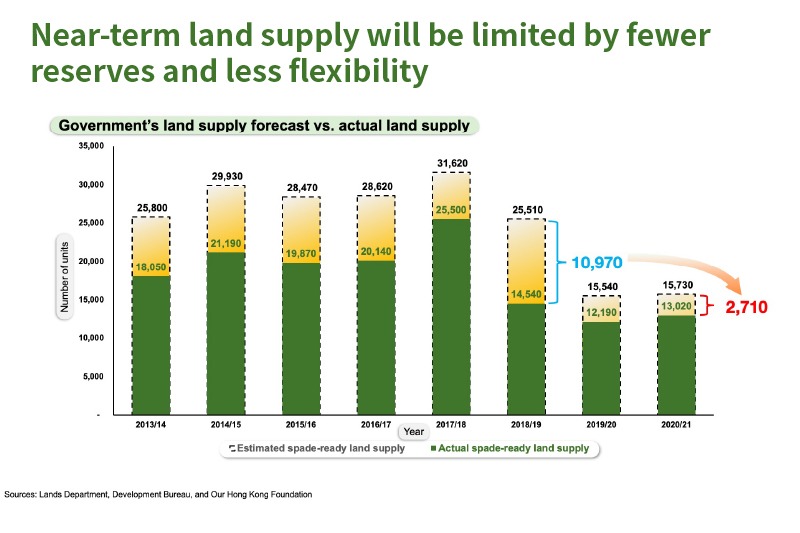
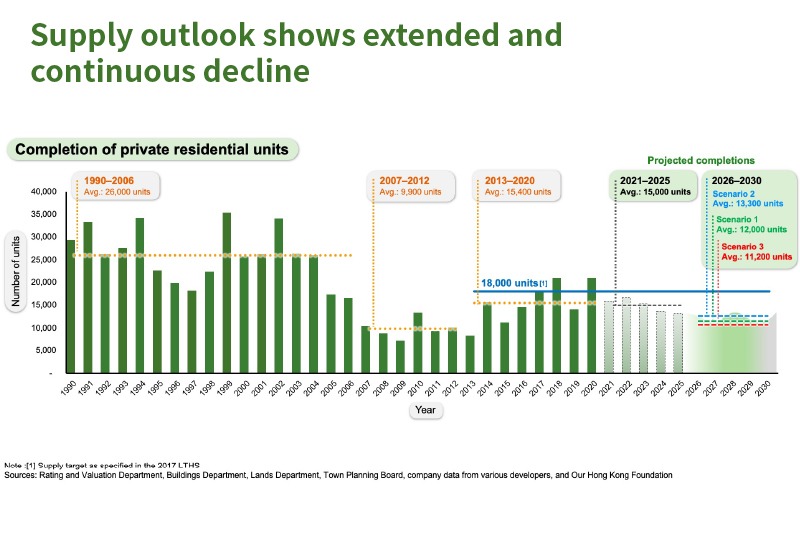
To assess whether the Government could achieve its LTHS ten-year housing supply target, we have provided an exclusive ten-year forecast on public and private housing supply and a quantitative analysis on reaching the LTHS target. The Government has announced in the 2020 Policy Address that it had identified all the land required for 316,000 public housing units in the next ten years. However, based on OHKF forecast, if all land supply initiatives continue to progress at the current speed, only some 277,400 public housing units could be completed in the same period. To achieve the figure stated in the Policy Address, New Development Areas and other major land supply initiatives will need to be completed with an expedited timeline, approximately two years ahead of their current schedules. In addition, the annual supply of flats from rezoning needs to be increased by 5% over the current level. For private housing, we expect only an average of 12,000 units per year to be completed in 2026–2030. This is 20% lower than the annual average of 15,000 units between 2021 and 2025, and fails to reach the annual target of 12,900 units in the LTHS. If the Government wishes to fulfil the LTHS target, New Development Areas and railway projects need to be completed one year ahead of the original schedule, and supply from private development needs to deliver 5% more of units each year.
To solve the land and housing crisis in Hong Kong, the OHKF advises the Government to take a bold step forward and expedite all major land supply initiatives, including development of New Development Areas, rezoning, topside development on railways, urban redevelopment and others, while streamlining the current administrative procedures for land and housing development. Specifically, we advocate that the Government conducts in-depth study on compressing the development procedures of New Development Areas, and speeds up transport infrastructure projects that support New Development Areas, in particular road infrastructure including Route 11, Tuen Mun Western Bypass, and Lantau Road P1, as well as railway infrastructure including the Northern Link, Tuen Mun South Extension, and Tung Chung Line Extension. Moreover, the OHKF urges the Government to ensure the newly set up Development Projects Facilitation Office announced in 2020 Policy Address can perform its functions effectively to streamline the administrative and approval processes in public and private housing development. On public housing supply, OHKF land report in 2020 has pointed out that many public housing projects may be delayed due to different bureaucratic procedures. The OHKF calls on the Government to leverage on the Steering Group on Streamlining Development Control, with its expanded function from the Policy Address, to improve cross-department coordination and streamline cumbersome government procedures to compress the timeline of public housing development.
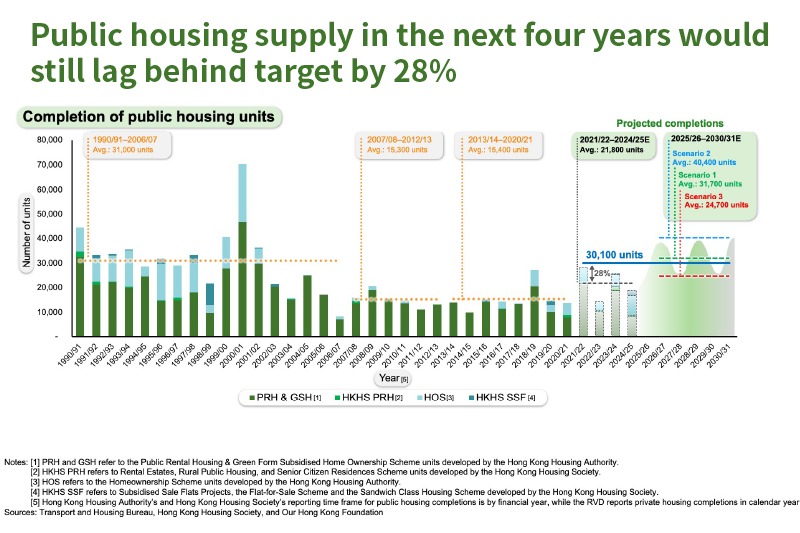
2021-2-8
Our Response to the 2021-22 Budget on Land and Housing Policy
[Presentation Slides (Read Flipbook)(Chi Only)]
[Presentation Slides (Download PDF)(Chi Only)]
Our Hong Kong Foundation (OHKF) released “Our response to the 2021-22 Budget on Land and Housing Policy”. Three main recommendations were put forward in the hope that the Budget could reboot the epidemic-stricken economy and bring long-term investment to the society. The three respective recommendations are investing in infrastructure, re-launching the “Tenants Purchase Scheme 2.0”(“TPS 2.0”) and streamlining development procedures for public housing projects.
In support of the TPS2.0 advocacy, OHKF also released the results of a telephone survey on Hong Kong residents' attitude towards a“Universal affordable housing” proposal and a TPS 2.0 proposal. The survey found that more than 80% respondents agreed to implement "Universal affordable housing” which proposes to allow most people to buy a public housing unit at an affordable price. It also found that more than 70% respondents agreed to relaunch TPS 2.0 which proposed to allow public housing tenants to buy their own units at 20-50% of the market price. It was also found that not only almost 90% public housing tenants agreed to relaunch TPS 2.0, indeed even among private housing occupants, nearly 70% also agreed to the proposal. The claim of the so-called “red-eye syndrome”from private housing occupants therefore does not stand. The survey was conducted by Lingnan University’s Public Governance Programme. Random sample telephone surveys were conducted between 28 October and 2 November 2020. 1,552 Hong Kong residents aged 18 or above were successfully interviewed. The OHKF survey suggests that consensus opinion generally supports the government to re-launch TPS 2.0. OHKF hopes that the government will seriously consider TPS 2.0, which has been a major advocacy from the OHKF.
2020-10-12
Analysis on the Benefits and Possible Development Models of Lantau Tomorrow Vision
[Presentation Slides (Read Flipbook)(Chi Only)]
[Presentation Slides (Download PDF) (Chi Only)]
Our Hong Kong Foundation (OHKF) recently released its analysis on the benefits and possible development models of Lantau Tomorrow Vision. As a large-scale infrastructure project, Lantau Tomorrow Vision not only achieves counter-cyclical effect in times of economic downturn, but also creates a wide range of jobs, maintaining employment in the city. Indeed, the benefits brought by Lantau Tomorrow Vision alone outweigh its costs. In addition to benefiting from significant land sale proceeds, the community can also reap other benefits including 180,000 public housing units and around 200,000 new jobs, as well as strategic transport network bridging Hong Kong Island and the New Territories.
While there are concerns that Lantau Tomorrow Vision would impose a heavy burden on the government, OHKF pointed out that the government had adopted a vast array of development models for large-scale projects in the past, to minimize impacts on cashflow and ease its financial burden. Examples include the sale of development rights, the "Payment-before-delivery" model, the establishment of a specialized agency, the BOT model (Build-Operate-Transfer), the “Rail-plus-property” mode, and so on. OHKF suggested the Government to adopt development models according to the project natures; we also called for the Government to explore suitable models in its preliminary study, so as to provide a clear direction for Lantau Tomorrow Vision.
2020-8-28
Discussion on Brownfield Development Strategy
[Presentation Slides (Read Flipbook)]
[Presentation Slides (Download PDF)]
Our Hong Kong Foundation (OHKF) released our study on brownfield development strategy in response to the “Shortlisted Brownfield Clusters for Public Housing Development (First Phase)” published by the Planning Department earlier this year. Among the eight brownfield clusters proposed by the Government, while we found the Ping Shan North Cluster is under better conditions, the other seven clusters will encounter major obstacles in future development, including limited site area, underdeveloped local road network and need to relocate existing occupiers, thus they are unlikely to supply housing units in the short run.
Thus, OHKF urges the government to consider the recommendations offered in the “Strategic Land Development for Jobs: From Brownfields to Modern Logistics” report published in July this year, to develop large-scale integrated operations nodes in multiple transport strategic locations to resettle and consolidate existing brownfield operations, and build up land reserve for the future development of our priority industries.
2020-7-28
Strategic Land Development for Jobs: From Brownfields to Modern Logistics
[Full Report (Read Flipbook)]
[Executive Summary (Read Flipbook)]
[Presentation Slides (Read Flipbook)]
[Full Report (Download PDF)]
[Executive Summary (Download PDF)]
[Presentation Slides (Download PDF)]
Our Hong Kong Foundation (OHKF) published its latest Land & Housing Policy Research Report, “Strategic Land Development for Jobs: From Brownfields to Modern Logistics”.
The report pointed out that the Government’s lack of a strategic economic and industrial blueprint, coupled with inadequate infrastructure investment, had led to an acute land shortage for the logistics industry. The outlook for our logistic industry will be precarious should the Government fail to provide timely policy support.
All sectors of the logistics industry, including the maritime and port industries as well as the airfreight sector, are constrained by the shortage of industrial space. Take the maritime and port industry for example: Hong Kong Port has the smallest yard area as a proportion of throughput among the world’s busiest port. It is relegated by competing ports in the region, and saw its global ranking dropping from the first to the eighth place. In addition, OHKF’s analysis shows that at present, more than 40% of the port back-up land near the Kwai Tsing container terminals has not been fully utilized.
While the trading and logistics industry’s GDP contribution grew by 51% from 2009 to 2018, built-up industrial land only recorded a meagre increase of 8%. There had even been a supply vacuum in the completion of private storage. At the same time, existing flatted factories, which were designed in the old industrial era, have long failed to meet the market’s needs. The tight supply of industrial land in Hong Kong and the persistently low vacancy rate have inevitably pushed up rents.
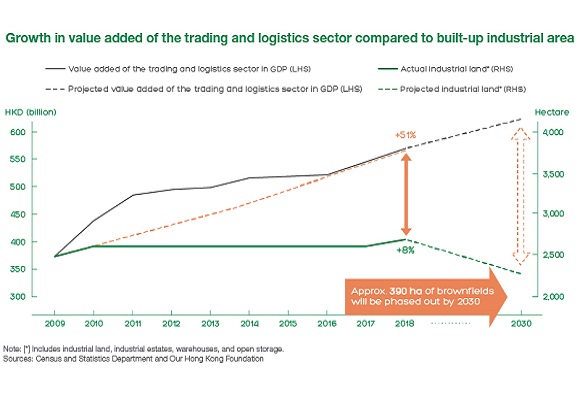
Under-supply of industrial space in has prompted logistics operators to turn to affordable space in the New Territories. This gives rise to the emergence of brownfield, which is often misunderstood by the society. Currently, 46% of the 1,414 hectares of active brownfield sites are occupied by logistics-related industries. According to OHKF estimates, there will be 390 hectares of brownfields being reapportioned for housing and other development by 2030.
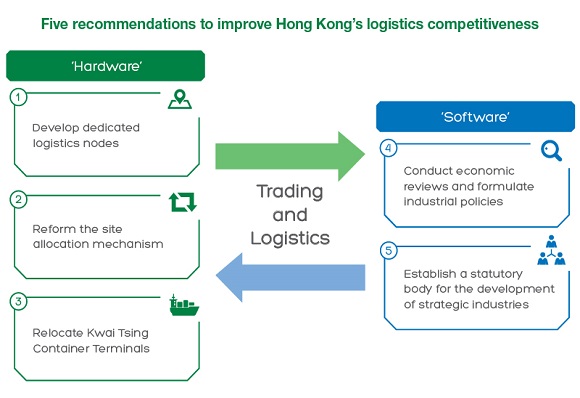
In view of an alarming outlook for one of the four key industries in the city, OHKF presents a set of five policy recommendations to address the current challenges. OHKF urges the Government to provide adequate land and facilities in a timely manner, and to establish an effective governance structure in support of our strategic industries. Only by doing so can we provide a way forward for sustainable development of the logistics industry.
2020-4-20
Cutting Red Tape to Catch Up with Shortfalls in Land and Housing Supply
[Full Report (Read Flipbook)]
[Executive Summary (Read Flipbook)]
[Presentation Slides (Read Flipbook)]
[Full Report (Download PDF)]
[Executive Summary (Download PDF)]
[Presentation Slides (Download PDF)]
Our Hong Kong Foundation (OHKF) launched its latest Land & Housing Policy Research Report. “Cutting Red Tape to Catch Up with Shortfalls in Land and Housing Supply”.
The report highlights that housing supply has plunged with no signs of rebound. The present housing crisis is likely to be exacerbated, as the report shows that various cumbersome administrative procedures cripple the development of housing supply.
Construction activities of private housing have drastically slowed down in 2019. Leading indicators of the development cycle, including spade-ready land supply, superstructure commencement, and presale consents all recorded a sharp reduction of 35-53% from their respective peak levels over the past one to two years. Taking into account the industry slowdown, OHKF estimates the average annual completion of private housing to be 16,000 units in 2020-2024, down 14% from our previous estimate for 2019-2023.
The report also estimates that the average annual completion for public housing will be 20,400 units, which is 32% lower than the Government’s supply target of 30,100 units. In the report, we also scrutinise three cases, in which housing projects do not proceed smoothly beyond the stage of rezoning due to delays in subsequent procedures.
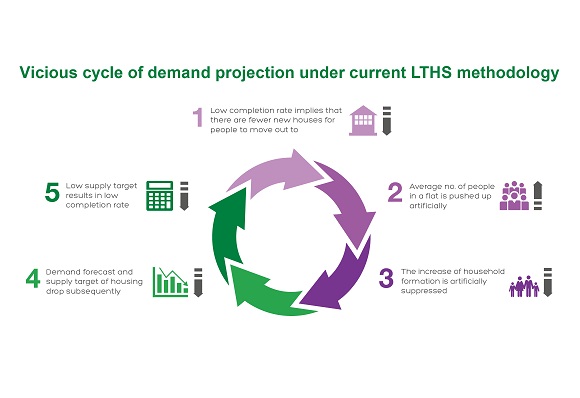
OHKF also reviewed the current methodology of Long Term Housing Strategy in household projection, and explained why the methodology would lead to a vicious cycle of downward revision of the supply target.
In view of a dire supply outlook, OHKF urges the Government to expedite on land development projects, and to review and streamline the existing administrative procedures on land and housing development.
2019-9-25
Vision of Universal Affordable Housing in Hong Kong
[Policy Recommendation Outline (Read Flipbook)]
[Policy Recommendation Outline (Download PDF)]
Our Hong Kong Foundation (OHKF) has just released our new housing policy initiative, namely “Vision of Universal Affordable Housing in Hong Kong”. Through our research, we found that property prices have increased by more than five times over the past 15 years, while median household income has just increased by a meagre 80% over the same period. This reflects the growing gap between those with properties and those without. In view of this, we hope our new initiative could provide the government and the community with a comprehensive housing policy blueprint that could narrow the wealth gap between the “haves” and the “have-nots”.
We have made reference to the Singaporean housing model to outline a viable path based on the circumstances in Hong Kong. We believe the only way to tackle the current housing crisis is to understand the problems faced by different sectors of the society.
Through a set of ten policy recommendations, such as the refined Tenants Purchase Scheme (TPS 2.0), a Buy-or-Rent Option for new public housing, rent subsidies, fixed premium, and interest-free loans to first-time buyers, etc., the initiative aims at providing assistance for the achievement of homeownership for all sectors of the society: existing Public Rental Housing (PRH) tenants, households on the PRH waiting list or currently living in sub-divided units, owners of Subsidised Sale Flats (SSFs) with premium unpaid, White Form households, and young first-time homebuyers. The ultimate goal is to enable 70% to 80% of Hong Kong citizens to eventually become owners of permanent properties and be able to share the fruits of economic prosperity.
2019-4-17
Hanging on the Housing Supply Cliff - Are There More Bandages Around?
[Full Report (Read Flipbook)]
[Presentation Slides (Read Flipbook)(Chi Only)]
[Full Report (Download PDF)]
[Presentation Slides (Download PDF)(Chi Only)]
Our Hong Kong Foundation (OHKF) has launched the fourth report of its "Land and Housing Policy Advocacy” series, “Hanging on the Housing Supply Cliff: Are There More Bandages Around?”. We address the housing crisis faced by the city, towards which public attention has waned in recent months despite its persistent severity. Unfortunately, OHKF’s updated forecasts show that the worst is yet to come.
A continual depletion of the city's land bank means that sharp drops will be seen in both private and public housing supply in a few years' time. Our average annual private housing supply forecast for 2019-2023 has been adjusted downwards by 11% compared to our previous rolling five-year forecast for 2018-2022. In particular, completions in 2023 is forecast to drop to only 13,300 units, nearly 40% lower than the corresponding figure in 2018.
For the next four years, public housing supply is forecast to be 10% lower compared to the previous rolling four years. We expect the Government’s target of 31,500 units per year to be missed by a large shortfall of 42%. Over a 10-year horizon, we expect a cumulative shortfall of 85,000 units. We also expect the general applicants’ average waiting time for public rental housing to exceed 6 years in three years’ time.
In view of the significant shortfalls in public housing in the next 10 years, we urge the Government and society-at-large to speed up all land rezoning efforts, which is the main source of land supply in the short-to-medium term. We examined the potential rezoning sites demarcated by the Government in detail and prioritised different sites based on their difficulty-levels regarding the rezoning process.
OHKF also covers the issue of "brownfield" sites as important economic ancillary land to Hong Kong, and call for a comprehensive review by the Government for the current and future demand of land to facilitate the trading and logistics industry.
2019-1-17
Downward Spiral of Housing Demand Estimation
[Presentation Slides (Read Flipbook)(Chi Only)]
[Presentation Slides (Download PDF)(Chi Only)]
Our Hong Kong Foundation (OHKF) released its Land & Housing Advocacy Study ”Downward Spiral of Housing Demand Estimation" in response to the Government's updated Long Term Housing Strategy (LTHS). We observe that the demand for housing in the LTHS has continually been underestimated, failing to take into account the pent-up demand accumulated over the past decade. The adjustment of the housing supply target's public-private ratio from 60:40 to 70:30 fails to increase the overall target, and merely "robs one's belly to cover one's back".
Regarding private housing, there is now a lower annual average supply target. We also find that the availability of spade ready land for private housing development has fallen behind for the first time in four years, meaning that future completions will see a sharp downturn.
Taking into account the completion forecasts for the next four years, the Government will fail to meet its first 10-year public housing supply target announced four years ago. Also, in the past year, the Government has only been able to source land for public housing by reallocating land from private housing. Complications with rezoning, increased plot ratios and more have contributed to more delays in the delivery of public housing.
2018-8-7
Re-imagining Hong Kong with a Game-Changer: Enhanced East Lantau Metropolis
[Full Report (Read Flipbook)]
[Booklet (Read Flipbook)]
[Leaflet (Read Flipbook)]
[Full Report (Download PDF)]
[Booklet (Download PDF)]
[Leaflet (Download PDF)]
Our Hong Kong Foundation (OHKF) has released their most significant research report since their inception three and a half years ago. They propose to construct an island in the waters between Hong Kong Island and Lantau that will become the base of a smart and liveable metropolis that can accommodate up to about a million people. The proposed island will have a land area of 2,200 hectares, equivalent to half the size of Kowloon. In order to strike a balance between environmental protection / ecological conservation and economic development, OHKF partnered with internationally-renowned management consultant, McKinsey & Company; engineering consultant, Arup; environmental consultant, Environmental Resources Management (ERM); and traffic management consultant, OZZO Technology (HK) Ltd, to jointly conduct preliminary studies on multiple aspects including water depth, hydrodynamics, marine traffic and operations, engineering work, costs, various land restrictions, and submarine utilities.
As seen in the past experiences of developing the new towns of Sha Tin, Tuen Mun, Tseung Kwan O and Tung Chung, Hong Kong with its natural hilly terrain has tackled the shortage of land through reclamation. However, Hong Kong has lagged behind Singapore, Macau, Shenzhen and Saemangeum in South Korea in terms of large-scale reclamation in the past decade - a period when Hong Kong simply halted land creation despite growing social and economic needs. OHKF’s proposal builds on the Government’s strategic plan of the East Lantau Metropolis mentioned in “Hong Kong 2030+”, and suggests an even bolder, more forward-looking and imaginative, and considerably bigger undertaking of reclamation to create an "Enhanced East Lantau Metropolis”.
2018-4-17
Lacunae in Land Planning: Undersized, Undersupplied and Underestimated
Our Hong Kong Foundation (OHKF) launched the third report of its "Land and Housing Policy Advocacy” series,“Lacunae in Land Planning: Undersized, Undersupplied and Underestimated”today. The shortage of land supply continues to put Hong Kong in a dire situation where housing – a priority concerning the public with significant implications – is regressively undersized, undersupplied and underestimated. It has caused local property prices to skyrocket beyond the norm of inflation, depressed the quality of life below historical trends, and hurt the city’s long-term competitiveness as a centre of international business. As such, Our Hong Kong Foundation (OHKF) believes that land and housing is currently one of Hong Kong’s greatest challenges.
We have noted the average size of newly constructed residential units in recent years to be substantially smaller compared to the previous norm. Also, we have found that rezoning has become the primary means of land supply, which is highly uncertain and ineffective. More importantly, we have found the actual demand for land and housing to be far greater than that anticipated in the government consultation, “Hong Kong 2030+: Towards a Planning Vision and Strategy Transcending 2030. We believe Hong Kong will need more than 9,000 hectares of new land (roughly three times the size of Sha Tin) over the next three decades, instead of 4,800 hectares as estimated by the government. Compared to other avenues of land supply, OHKF believes that reclamation is the only way of providing Hong Kong with high-quality land as a long-term solution. Hence, OHKF reiterates its suggestion to the government to consider it as a viable option to tackle the mounting challenge of land and housing shortage.
2017-10-23
Housing Policy Reform to Narrow Wealth Gap Urgent Formation of Land to Improve People’s Livelihood
Our Hong Kong Foundation (“OHKF”) has launched the third report of its Land and Housing Research Series today. The report intricately analyses defects in the design of the existing public housing mechanism and its associated inefficiencies. These include a severe lack of opportunity for PRH tenants to move between units, unsustainable burden on public finance, etc. In response, OHKF believes that housing policy must be transformed to become homeownership-oriented. This can ameliorate issues derived from income disparity and intergenerational poverty. To share wealth with the people, the report recommends that the government implement the “Subsidised Homeownership Scheme”, with prices of public housing units linked to the development costs and the unpaid premium capped at the date of occupation and thus delinked with the fluctuating market value.
As a continuation of OHKF’s advocacy report “From Large-Scale Reclamation to an Ideal Home” published in April this year, the second part of this report continues to explore issues relating to land supply. It proposes short, medium and long-term solutions to the severe land shortages faced by the city. In the short to medium-term, OHKF recommends implementing a Public-Private Partnership (PPP) scheme to release the development potentials of privately-owned land and increase the supply of housing. In the long-term, the report stresses again that the ideal solution is large-scale reclamation outside Victoria Harbour to create large, flat and high-quality developable land and build a significant land reserve.
2017-04-27
From Large Scale Reclamation to an Ideal Home
[Full Report (Read Flipbook)]
[Presentation Slides (Read Flipbook)(Chi Only)]
[Full Report (Download PDF)]
[Presentation Slides (Download PDF)]
Our Hong Kong Foundation (OHKF) launched the second report of its "Land and Housing Policy Advocacy” series, “From Large-Scale Reclamation to an Ideal Home”, in response to the government’s “Hong Kong 2030+: Towards a Planning Vision and Strategy Transcending 2030” consultation. OHKF forecasts that the average completion of private residential units to be 20,200 in 2017 to 2020, which meets the target set by the LTHS and is 85% higher than that of the preceding decade. However, public housing is still chronically undersupplied, and the average waiting time of public rental housing has increased rapidly. In the long term, OHKF estimates that Hong Kong will require more than 1.26 million units of housing over the next 30 years, translating into more than 9,000 hectares of land. Yet, the government’s existing land development plans can only provide 5,300 hectares of land.
Hong Kong’s development is a story of reclamation. It is not only the cornerstone of the development of new towns, but also an important source of land for public and private housing. But in recent years, reclamation have halted, and Hong Kong is seriously falling behind its neighbours. As a result, the residential land available for reclamation from the past will soon be depleted. To ensure the continued and stable supply of land and establish a land reserve in the long-term, OHKF suggests that the Government should restart large-scale reclamation and proposes a number of reclamation sites. Together, we can build our “New Rose Garden”. In the short and medium term, OHKF recommends the government to consider ways of releasing private land bank to increase housing supply through public-private partnerships.
2016-10-04
Rethinking Public Housing Policy Building Sustainable Land Reserve
[Full Report (Read Flipbook)]
[Part One Executive Summary - The Price of Our Public Housing Programme (Read Flipbook)]
[Part Two Executive Summary - Macro Considerations Surrounding Land Supply (Read Flipbook)]
[Part One - The Price of Our Public Housing Programme (Read Flipbook)]
[Part Two - Macro Considerations Surrounding Land Supply (Read Flipbook)]
[Full Report (Download PDF)]
[Part One Executive Summary - The Price of Our Public Housing Programme (Download PDF)]
[Part Two Executive Summary - Macro Considerations Surrounding Land Supply (Download PDF)]
[Part One - The Price of Our Public Housing Programme (Download PDF)]
[Part Two - Macro Considerations Surrounding Land Supply (Download PDF)]
Our Hong Kong Foundation (OHKF) releases its second public policy research report in the area of land and housing. The report recommends that the Government implement the “Subsidised Homeownership Scheme” (SHS) and change the existing mechanism determining the unpaid premium by fixing the amount at the time of purchase, so that households will no longer have to catch up with ever-increasing property prices. The report also examines the malign issues arising from the current public housing policy alongside the urgency and necessity of implementing the SHS. OHKF believes that the proposed Scheme will help grass-roots families purchase their own homes and in the long-term, improve social mobility, alleviate income inequality and inter-generational poverty.
Moreover, the report extends the findings of OHKF’s previous research entitled "From Housing Market Outlook to Land Supply Strategy" published in July. It is proposed that Government should strive to establish a land reserve and to implement the Lantau Development as soon as possible, and calls for greater societal cohesion and consensus to support land development. Land supply involves the interests of the community as a whole. OHKF believes that mere debates and arguments will not help improve the situation. Only by recognising the severity and urgency of the problem of land and housing shortages, and supporting faster land development, can ensure that Hong Kong enjoys a sustainable future.
2016-07-13
From Housing Market Outlook to Land Supply Strategy
[Presentation Slides (Read Flipbook)]
[Presentation Slides (Download PDF)]
Our Hong Kong Foundation (OHKF) releases its research report “From Housing Market Outlook to Land Supply Strategy” today. OHKF believes that whilst housing supply is expected to increase, demographic structure and other socio-economic indicators suggest that there is still an abundance of genuine end-user demand for housing in Hong Kong, and the medium- to long-term supply situation remains grim. There is no room for the government to slow down in housing and land production. In addition, OHKF opines that given the numerous challenges faced by the development of “brownfield sites”, it is unrealistic for the community to expect it as a prioritised avenue of land supply. Over the longer term, reclamation and developing new towns are still important and the more effective land development options for the city.
2015-11-09
Maximizing Land Use to Boost Development Optimizing Housing Resources to Benefit All
[Full Report (Read Flipbook)]
[Part One Executive Summary - Subsidized Homeownership Scheme (Read Flipbook)]
[Part Two Executive Summary - Increasing Land Supply (Read Flipbook)]
[Part One - Subsidized Homeownership Scheme (Read Flipbook)]
[Part Two - Increasing Land Supply (Read Flipbook)]
[Full Report (Download PDF)]
[Part One Executive Summary - Subsidized Homeownership Scheme (Download PDF)]
[Part Two Executive Summary - Increasing Land Supply (Download PDF)]
[Part One - Subsidized Homeownership Scheme (Download PDF)]
[Part Two - Increasing Land Supply (Download PDF)]
Our Hong Kong Foundation today released our- first research report, with focus on Hong Kong land and housing policies. In housing, we advocate that the Government launch a “Subsidized Homeownership Scheme” to utilize public housing resources more efficiently, to enable the underprivileged to become property owners with policy support, and in the long run to share in the wealth brought by Hong Kong’s economic prosperity.
Housing is inseparable from land supply. In the past decade or so, Hong Kong’s reclamation activities had ground to a halt, and there were very few major land development plans. Our Hong Kong Foundation advocates that the public should look at the macro situation and support a multi-pronged strategy to increase land supply — including reclamation. In the long run, Hong Kong must build its own land reserves to meet various economic, social and livelihood needs.



